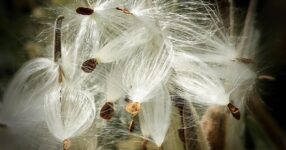Almost everyone has heard that our beautiful Monarch butterflies across the United States are in decline. Fortunately, many gardeners and property owners, including farmers, are taking steps to help the population rebound. Habitat loss is the main reason for the butterfly decline, according to the experts. It’s also at least partly responsible for the decline in bumble bees and other beneficial or desirable wildlife species. Habitat loss is due to intensive agriculture, urbanization and use of herbicides in cropland, pastures and roadsides to kill weeds, and until recently milkweed (Asclepias) was considered another common weed.
Milkweed is used by many pollinators and other insects, but it is essential as a food source for Monarch caterpillars. The adults can feed on the pollen of milkweed, and also of other plants, but the caterpillars rely on the alkaloid sap in the milkweed foliage and stems to make them taste bad to predators. Adult Monarchs in California overwinter in coastal forest groves and migrate to our area in the spring and summer to feed, mate, and lay their eggs on milkweed plants. The larvae emerge, eat, pupate and by fall are ready to migrate as adults. Some of the Monarchs head north instead of east and summer as far away as British Columbia.
We’ve started to see some recovery in Monarch populations, as property owners avoid further destruction of milkweed stands. In many landscapes across California, home owners are creating colonies of Asclepias and other pollinator-friendly plants in their gardens, and have seen Monarchs visit for the first time in years. There are few things to understand, however, before you purchase whatever milkweed is available in the nursery center.
There are six regions of Monarch distribution, each with its own pattern of migration. California is a region by itself. The other regions are Arizona, Western, North central, South central, and Southeast. Each region has its own milkweed species. This makes sense since the climate is different in these different regions. In California, we have 15 species of milkweed. Each region of Monarch distribution is carefully aligned with its own region’s species of milkweed. So it is best to plant a milkweed species that is native to California.
The two California native milkweed species most commonly available in nurseries are “narrow leaf” (Asclepias fascicularis), and “showy milkweed” (Asclepias speciosa). Narrow leaf milkweed is the most widespread species in California. In one study, showy milkweed attracted the highest number of beneficial insects in addition to Monarch butterflies. Although it’s best to find locally-collected seed or plants, the next best thing is to use native species.
Other species of milkweed that are found in our area include California milkweed (A. californica), heartleaf (A. cordifolia), woolly (A. vestita), and woollypod (A. eriocarpa).
Milkweed is fairly easy to grow in the garden. All of the above-named varieties will grow in part sun, full sun and part shade. Most of them have pink, white or purple flowers in large masses from late spring through fall. The seeds are held in pods (fruits), and woolly or hairy stems help distribute seeds in a breeze. Don’t over-water milkweed; our local native Asclepias do not like a lot of water in the summer! Aphids can be a problem of young plants or on mature plants early in the spring. Control by spraying the plants with water or use a very low toxicity pesticide like insecticidal soap. Never use a systemic aphid killer on milkweed, or on any of your pollinator plants (including roses) if you don’t want to harm the insects, including butterflies, who feed on the pollen. Milkweed die to the ground in the winter and emerge again when the soil warms. Sometimes the plants emerge quite late in the year. Don’t worry! They are perennials and don’t need to be re-planted every year.
And what about those easily-available exotic (non-native) milkweed species? The three that we find are “butterfly weed” (A. tuberosa), “tropical milkweed” (A. curassavica) with orange or yellow flowers, and “African milkweed,” (A. fruiticosa). These are not generally recommended to use as they are all designed to support Monarchs from different regions (two are not even from the United States) and have shown in some cases to have a harmful effect on the health and migration pattern of our native Monarchs. Especially important is to not plant them if your property borders any open lands, in order to not introduce a potentially-harmful invasive plant into the wild.
You should be able to find the native California milkweeds in your local nursery. It’s not too late to plant now–although the plant will go dormant during winter, it should reappear next spring, and hopefully welcome a travelling Monarch to stop by to have a snack.
Questions? Call the Master Gardeners:
Tulare County: (559) 684-3325, Tues & Thurs, 9:30-11:30;
Kings County: (559) 852-2736, Thursday Only, 9:30-11:30 a.m




